The climbing varieties of honeysuckle (lonicera) bear sumptuous, often sweetly scented blooms from early summer to autumn. Some also have attractive evergreen foliage. Growing climbing honeysuckle vines in your garden can add amazing displays of cascading flowers. Bees will LOVE your garden! And so will you ?
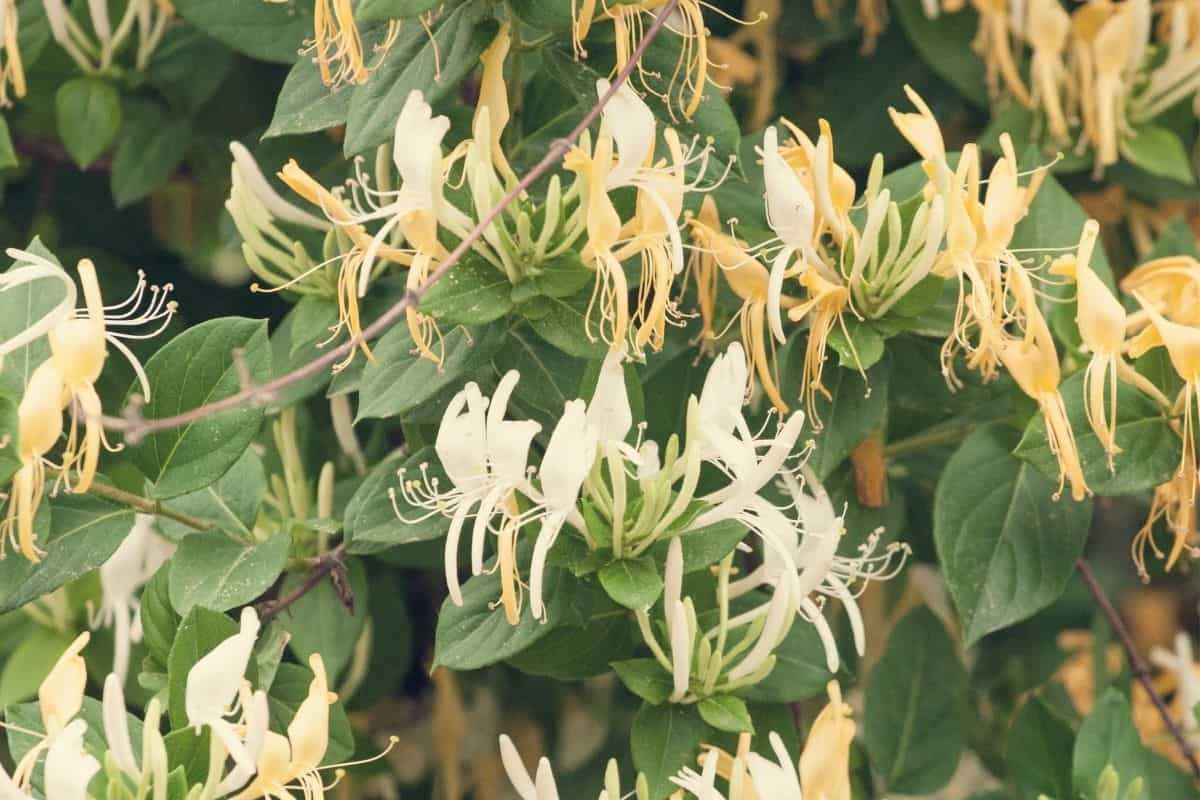
Before we get into the how-to, let’s take a look at why you might want to grow honeysuckle plants. Honeysuckles are among the most popular and easy to grow groups of climbing shrubs for the garden. Most are fully hardy. They require little maintenance, they do well in many climates, and they are beautiful to look at. They also smell really great. They will attract hummingbirds to your garden which you can enjoy watching.
Their twining habit makes them ideally suited to scramble through other shrubs or trees and, with suitable wire or trellis support, to be grown against a wall or fence.
Some can also be used as ground cover. They range in height from around 6 feet to 15 feet or more.
Most varieties have attractive glossy green deciduous foliage, but some are semi-evergreen or evergreen. One popular variety, Lonicera Aureoreticulata, has pretty gold-veined semi-evergreen leaves.
Early spring honeysuckle like Lonicera fragrantissima is a bushy shrub that grows from 6 to 10 feet tall. It has sweet-smelling white blossoms, usually from March to April. Climbing honeysuckle is also called trumpet honeysuckle because of the tubular flowers, which can look like trumpets. Now, let’s learn more.
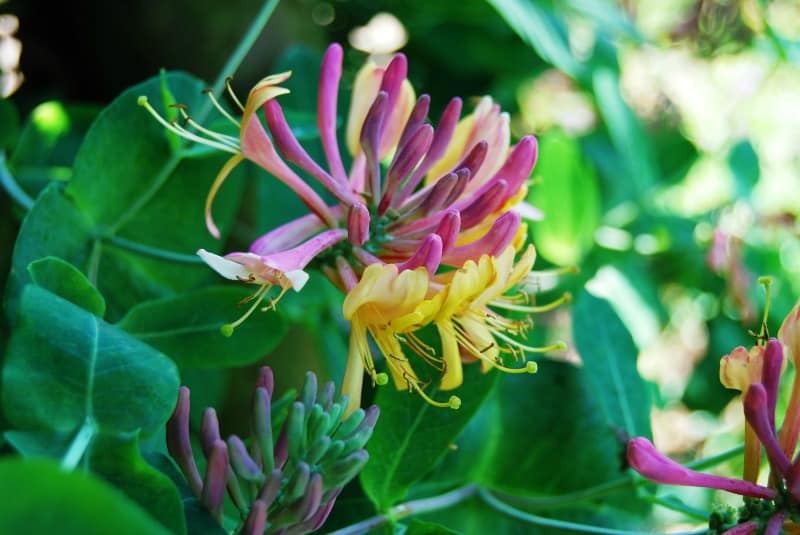
Honeysuckle Cultivation
Different varieties thrive in different situations, some preferring full sun, but most liking at least some shade. Follow the grower’s instructions for your particular variety.
I will include some tips below and some answers to frequently asked questions about the cultivation of honeysuckle.
They also like their roots to be in cool, shady soil, so if you’re planting in full sunlight, shade the root area with under-planting or flagstones.
Always plant at least a foot away from any wall to avoid the dry zone.
Honeysuckles like rich but well-drained soil, so dig in plenty of peat or compost and fertilizer when planting. Don’t plant too deeply.
Honeysuckle in the spring
How do you care for honeysuckle in the spring? The honeysuckle plant has both vines and shrubs. How you care for them will depend on which type you have. Honeysuckle bushes are best when pruned in the spring.
For honeysuckle vines, you can lightly prune any time of the year. Big pruning jobs should be held off until fall or winter when the vine becomes dormant. Honeysuckle usually flowers from summer into early autumn. The best thing you can do for them in the spring is to be sure they have the right conditions in order to grow properly and bloom when the time is right.
How fast does honeysuckle grow?
Honeysuckle is a very attractive plant that can reach as much as 30 feet long. However, it can take from five to ten years for it to get there. It is rapidly growing when compared to other plants and can grow as much as 9-12 feet per year, depending on the variety.
Which honeysuckle is the most fragrant?
The most fragrant honeysuckle varieties are the woodbine honeysuckles (Lonicera x peryclimenum).
Lonicera fragrantissima (Sweetest Honeysuckle) is a bushy deciduous shrub that is also known for its great fragrance. The fragrant flowers will also attract hummingbirds that you can watch from your windows. And they also attract bees and other pollinators.
Do bees like honeysuckle?
Bees love nectar-rich flowers so it’s no surprise that they like honeysuckle. The sweet aroma will attract both birds and bees. It also provides food and shelter for them.
Pruning Honeysuckle Bushes
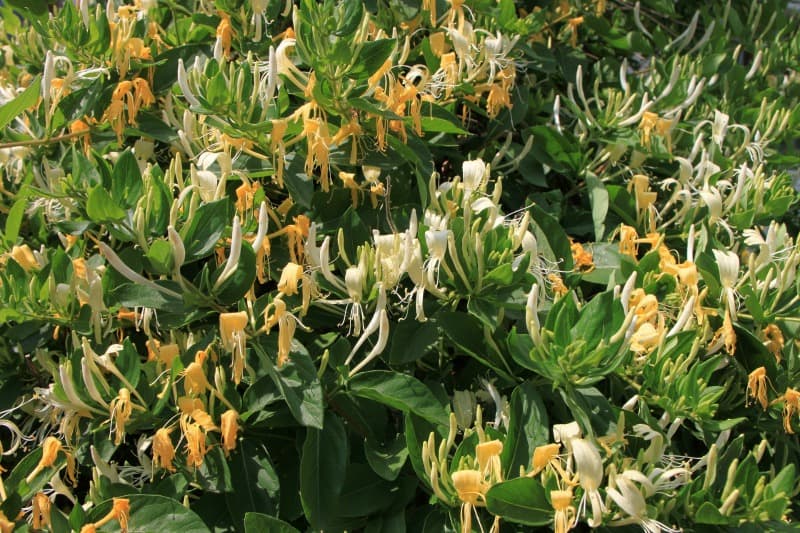
Climbing honeysuckles don’t normally need pruning except to contain their size. However, cut back any weak shoots to encourage stronger growth.
When it is necessary to prune, it’s best done in the late fall, once the vine goes dormant.
Honeysuckle pests and diseases
Most honeysuckle vine species are disease resistant, but all are vulnerable to aphids. If you catch them early enough, and there are only a few of them, you might be able to chase them off with a stream of water from the hose. If your honeysuckle bush is invaded with aphids, you’ll need to use an insecticidal soap.
Honeysuckle vines can also be attacked by caterpillars. Pick them off the vines as soon as you see them.
Powdery mildew is another problem you might see on your honeysuckle plants. This is essentially mold, and it suggests there is not good air circulation around the plant. The most common reason for this is overcrowding, so it can be easily avoided. Also, if you begin to see overcrowding happening, you can take control and maintain it before it leads to diseases such as mold and mildew.
What is the preferred soil for honeysuckle?
There are different soil types that will work for honeysuckle but how do you know what is the best? The best soil is organically rich and very well-drained. Moist soil is okay, but it should not be soggy or overwatered without the ability to drain.
Ideal conditions are acid to moderately alkaline soil. You should look for a pH of 5.5 to 8.0.
You can also use organic plant food or fertilizer to really bring out the best in your honeysuckle plants. You can apply a balanced 10-10-10 all-purpose fertilizer in spring when the honeysuckle starts to produce new growth.
What kind of sun does honeysuckle need?
For the best results, you want your honeysuckle to be in a place to get full sun. Although it can do okay in partial shade or part sun, it will bloom much better when it gets the most sun possible.
Most varieties of honeysuckle grow well in hardiness zones 5 – 9. New plants may take a little longer to get established but once they begin, they can give you fast growth, again and again, each year.
Trumpet honeysuckle is native and native plants will do well in the climates they are native to. Some people find they have honeysuckle just growing in the wild on their property. If you’re lucky enough for this to be the case, you can nurture it to get the best results from it.
Detailed information about how to care for honeysuckle from the nursery can be found with the nursery.
It’s also a good idea to learn more about the different varieties of honeysuckle so that you can determine which you have or which you want to buy and plant. Let’s overview this now.
Honeysuckle Varieties
Among the most attractive and popular varieties, most of which are available from nurseries and internet suppliers are:
- Lonicera x Americana – scented 1 ½ – 2-inch yellow/cream flowers maturing white from mid-summer to autumn. Height 10-15 feet. Prefers a sheltered position in sun or shade.
- Lonicera brownii Dropmore Scarlet – 1 ½ – 2-inch orange/scarlet flowers with orange throats from mid-summer to autumn. Height 10-12 feet. Prefers part shade.
- Lonicera x heckrottii Goldflame – scented 1 ½ – 2-inch pink flowers with orange throats from early to late summer. Height 10-12 feet. Prefers a sheltered position in sun or part shade.
- Lonicera henryi – scented 1 ½ – 2-inch yellow/flowers with a flush of pink in early and mid-summer to autumn. Height 10-15 feet. Tolerates sun or shade.
- Lonicera Aureoreticulata – small but fragrant white flowers from mid-summer to autumn. Attractive yellow and green-veined semi-evergreen foliage. Good as ground cover. Height 10-15 feet. Prefers part shade.
- Lonicera periclymenum – the native European and SE Asian honeysuckle or woodbine. The two generally available cultivated varieties are: Lonicera periclymenum Belgica (dense heads of fragrant pink and red flower in mid-summer followed by red berries). Height 10 – 12 feet. Tolerates sun or shade. And Lonicera periclymenum Serotina, the late Dutch honeysuckle, (profuse, fragrant purple-red and white flowers from mid-summer to early autumn, coppery leaves, and purple-red autumn berries). Height 10 – 12 feet. Prefers part shade.
- Lonicera x tellmaniana – large clusters of copper yellow flowers with a red flush in late spring and early summer. Height 10 – 12 feet. Tolerates sun or shade.
- Lonicera sempervirens (trumpet honeysuckle, common name) – has showy trumpet honeysuckle flowers that are red on the outside and yellow on the inside. Is also called coral honeysuckle and is native to the Eastern United States.
Alternatives to honeysuckle
Other ornamental flowering climbing plants to consider along with honeysuckle are:
- clematis
- jasmine
- candy corn vine
- wisteria
- climbing roses
How can I tell what kind of honeysuckle I have?
Native honeysuckle vines have a specific look. One way to identify the type you have is to look at the leaves. You can also tell by whether it is a vine or a shrub. Sometimes the colors of the flowers can also help you, although this can be tricky since flowers from different varieties can look a lot alike.
Will honeysuckle last through the winter?
Some varieties of honeysuckle are evergreen and can retain their leaves throughout the winter. Late winter is too harsh for other varieties and they will die off from fall to winter but return when the weather is warmer.
For these, the growing season comes back in the spring. Semi-evergreen plants shed most of their leaves in late winter, just before the new ones start to grow in the spring, and so are only bare for a short time.
Honeysuckle Vine Pictures
The climbing honeysuckle vine has beautifully ornate flowers in a wide range of colors. From pure white to pink, gold, orange-scarlet, deep red to purple and bi-colored combinations. Many varieties have a wonderful fragrance. Pictures of types of honeysuckle can also help you
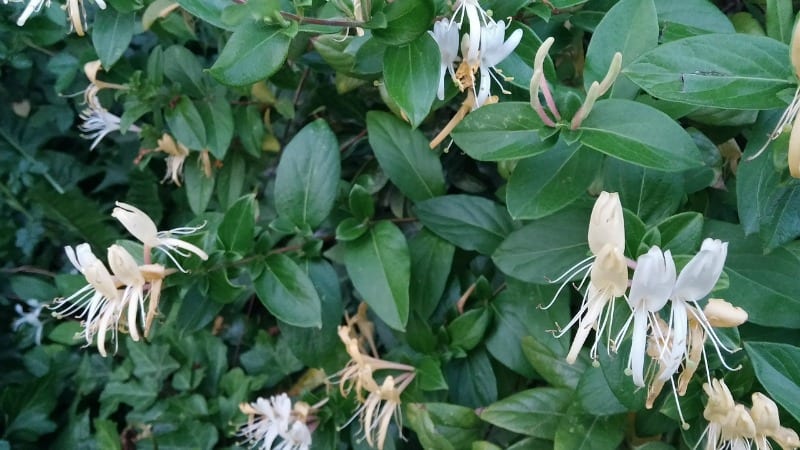
This is the most popular look for the climbing honeysuckle vines: at least this is what I remember from my childhood.
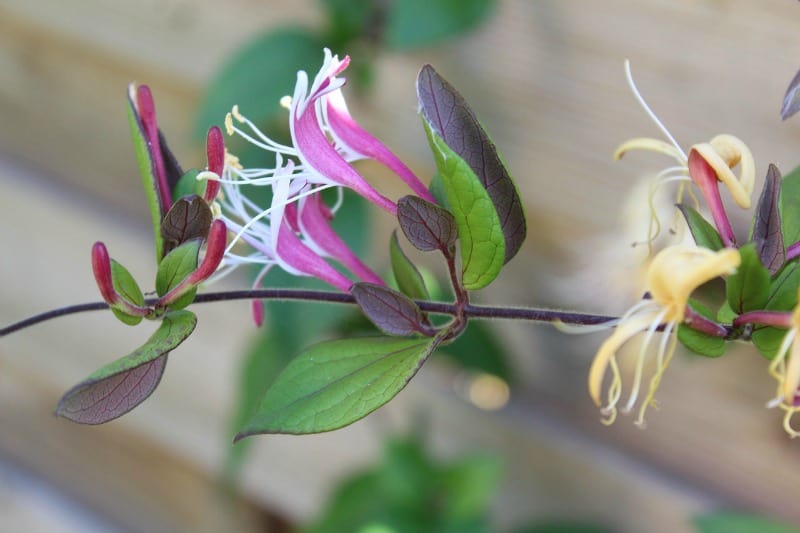
What a beautiful combination of colors! I love the mixture of yellow-white and purple pink in these flowers!
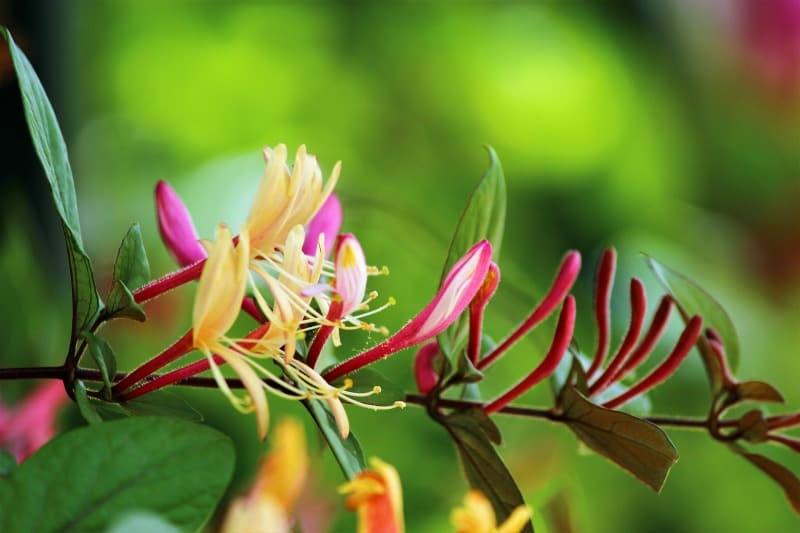
The deeper colors of this one are lovely! I wonder if this picture was taken after rain when everything is more vibrant!
How beautiful! I can only imagine the hummingbirds hovering around this brightly colored honeysuckle bush!
While honeysuckle can also be used as ground cover plants, most people use it as climbing vine, as we have discussed today.
If you want to train your honeysuckle to grow on a trellis or fence, you may need some added support structure so that it will go where and how you want it to.
Honeysuckle Vine – Conclusion
If these pictures don’t make you want to grow your own honeysuckle vine, I don’t know what will! This is a beautiful plant that will give you so many returns year after year, and it’s a great asset to the local ecosystem, too.
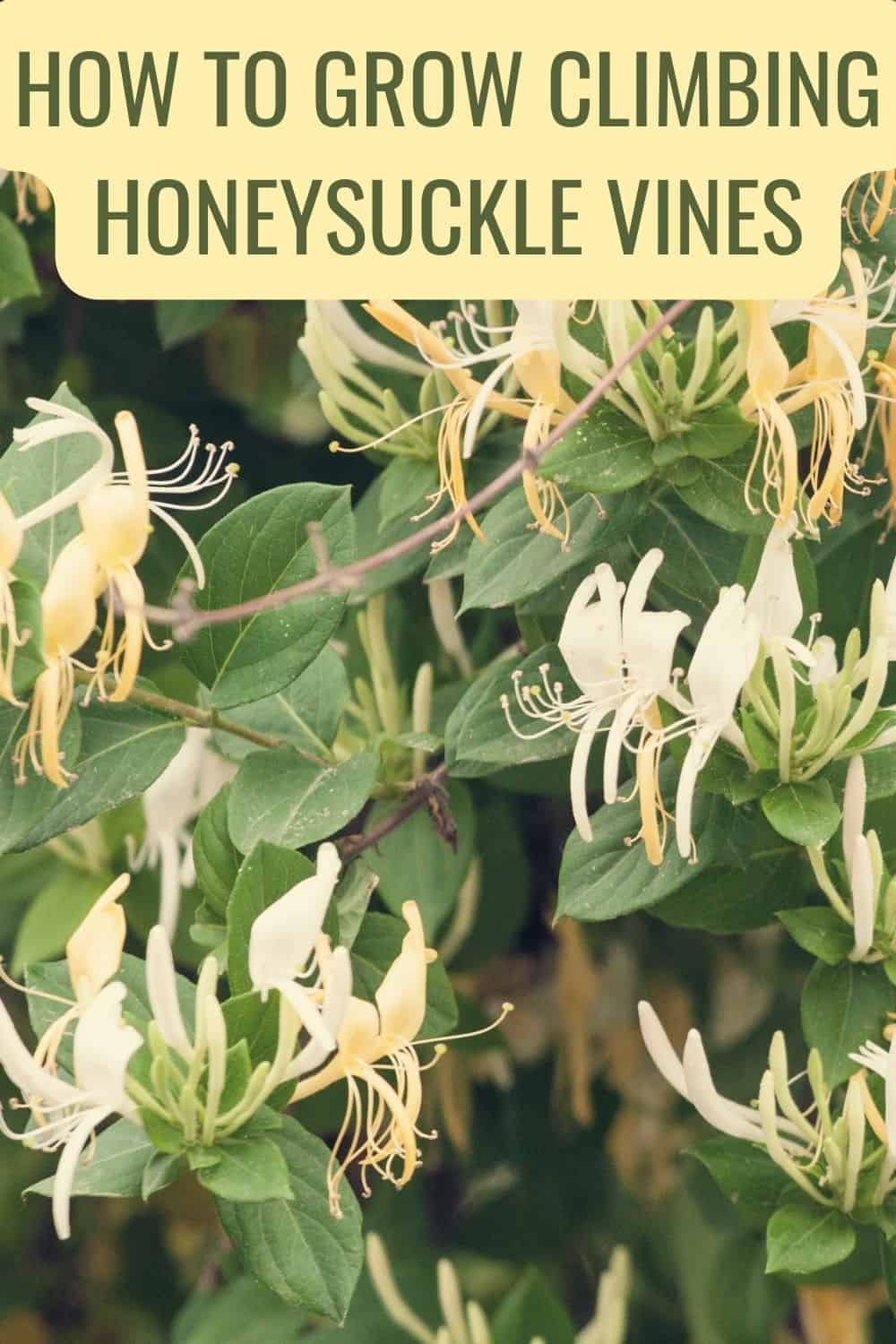





 ?. ts.dhung.
?. ts.dhung.